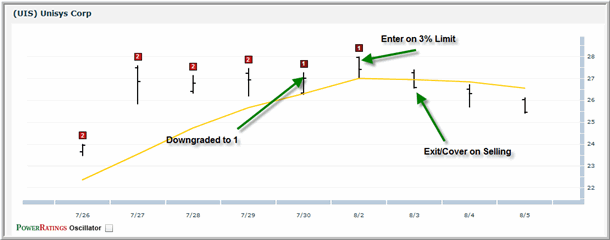Ultimate PowerRatings: Trading Strategies for Intraday Weakness and Intraday Strength
Earlier this week I talked about trading strategies for Ultimate PowerRatings using a portfolio approach.
The portfolio approach to trading stocks and ETFs using Ultimate PowerRatings calls for dividing a portfolio into at least 10 separate parts or tranches, with each tranche representing a potential stock or ETF PowerRatings position.
To read the discussion on portfolio trading with PowerRatings, click
here to read: Ultimate PowerRatings: Trading Strategies for PowerRatings Portfolios.
The portfolio approach helps reduce risk by diversifying over a number of positions, while at the same time increasing the trader’s exposure to potentially powerful edges in a variety of top-rated stocks, exchange-traded funds and leveraged ETFs.
When trading PowerRatings stocks and ETFs using the porfolio strategy, traders can and should use all of the same entry and exit techniques PowerRatings traders use when looking at trading invididual stocks and ETFs. For example, when it comes to adding stocks on the long side to a PowerRatings portfolio, buying on intraday weakness remains the rule to follow.
What is Intraday Weakness?
Buying on intraday weakness (or, for that matter, selling short on intraday strength) is a quantified approach to maximizing the edges in mean reversion trades with stocks.
To buy on intraday weakness, the trader waits for the stock to reach a level from which it has historically advanced. With Stock PowerRatings, this typically occurs when a stock reaches a Stock PowerRating of at least 9 or 10 (8 for very aggressive traders).
Rather than just buying the stock when its Stock PowerRating reaches 9 or 10, buying on intraday weakness calls for using a limit order anywhere from 2-6% below the close. The goal is not to buy the stock when it appears with its Stock PowerRating of 9 or 10. The goal is to buy the stock even lower on the subsequent day, as follow-through selling helps lower the stock to even more extreme levels.
The power of intraday weakness is impressive. As Larry Connors noted in his key report, How to Find the Best Stocks to Trade Every Day, the simple addition of the intraday weakness strategy can substantially improve both per trade gains and accuracy rates compared to a static exit after five days.
Read Larry’s article on intraday weakness here.
Note that traders looking to sell low-rated stocks short can also take advantage of “intraday weakness” – though here, we are looking at “intraday strength.”
To sell short using intraday strength, the traders follows a similar process. Here, a limit order 2-6% above the close of a 1- or 2-rated stock can allow a trader to sell a stock short from an even more extreme position should follow-through buying push the stock higher the following day – even if just on an intraday basis.
Below is an example of “intraday strength” at work in ^UIS^.

Shares of UIS earned a Stock PowerRating of 1 on July 30 with a close of 27.01. Using a limit order of 3% above that closing price, traders could get short in UIS if the stock rallied to 27.82 or higher on August 2.
UIS climbed as high as 27.98 on August 2, providing more than enough room for traders to take positions on the short side with the 3% limit.
One day later, the UIS closed below its 5-day moving average. For traders who use the 5-day moving average exit, this three day trade (downgraded to 1 on the 30th, entered on intraday “strength” on the 2nd, and exited on the 3rd) netted a gain of more than 4%.
Find out more about what Ultimate PowerRatings can do for you and your trading. Quantified ratings for stocks, ETFs and leveraged ETFs – all in one place.Click
here to launch your free, 7-day trial to our Ultimate PowerRatings today.
David Penn is Editor in Chief at TradingMarkets.com.
